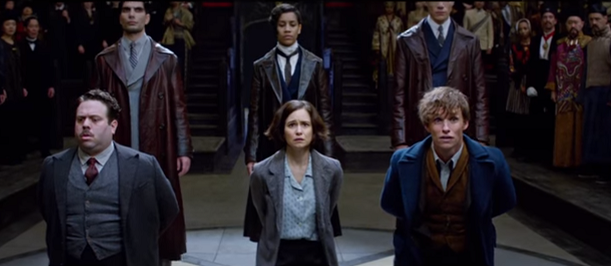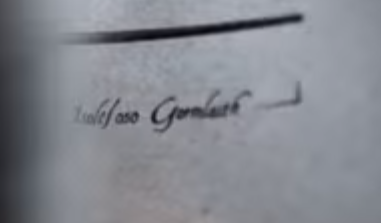Gormlaith’s Revenge
The happy, busy family had no idea that grave danger was approaching them from afar. News had reached the old country that a new magical school had been set up in Massachusetts. The rumour was that the headmistress had been nicknamed ‘Morrigan’ after the famous Irish witch. However, it was only when she heard that the name of the school was ‘Ilvermorny’, that Gormlaith could believe that Isolt had managed to travel all the way to America undetected, to marry, not just a Muggle-born, but an actual Muggle, and to open a school that educated anybody with a shred of magic.
Gormlaith had purchased a wand at the despised Ollivanders to replace the precious family wand that had been handed down through generations before Isolt stole it. Determined that her niece would not know of her coming until it was too late, she unknowingly imitated Isolt by disguising herself as a man to make the crossing to America on the ship Bonaventure. Wickedly, she travelled under the name of William Sayre, which was that of Isolt’s murdered father. Gormlaith landed in Virginia and made her way stealthily towards Massachusetts and Mount Greylock, reaching the mountain on a winter’s night. She intended to lay waste to the second Ilvermorny, slaughter the parents who had thwarted her ambition of a great pure-blood family, steal her great nieces who were the last to carry the sacred bloodline, and return with them to Hag’s Glen.
At her first sight of the large granite building rising in the darkness from the peak of Mount Greylock, Gormlaith sent a powerful curse containing Isolt and James’s names towards the house, which forced them into an enchanted slumber.
Next, she uttered a single sibilant word in Parseltongue, the language of snakes. The wand that had served Isolt so faithfully for many years quivered once on the bedstand beside her as she slept, and became inactive. In all the years that she had lived with it, Isolt had never known that she held in her hand the wand of Salazar Slytherin, one of the founders of Hogwarts, and that it contained a fragment of a magical snake’s horn: in this case, a Basilisk. The wand had been taught by its creator to ‘sleep’ when so instructed, and this secret had been handed down through the centuries to each member of Slytherin’s family who possessed it.
What Gormlaith did not know, was that there were two other occupants of the house whom she had not put to sleep, for she had never heard of sixteen-year-old Chadwick and fourteen-year-old Webster. The other thing she did not know, was what lay at the hearts of their wands: the horn of the river serpent. These wands did not become inactive when Gormlaith spoke her word of Parseltongue. On the contrary, their magical cores vibrated to the sound of the ancient language and, sensing danger to their masters, began to emit a low musical note, exactly as the Horned Serpent sounds danger.
Both Boot boys woke and leapt out of bed. Chadwick looked instinctively through the window. Creeping through the trees towards the house was the silhouette of Gormlaith Gaunt.
Like all children, Chadwick had heard and understood more than his adoptive parents had ever imagined. They might have thought that they had shielded him from any knowledge of the murderous Gormlaith, but they were wrong. As a small boy, Chadwick had overheard Isolt discussing her reasons for escaping Ireland and, little though she and James realised it, Chadwick’s dreams had been haunted by the figure of an old witch creeping through the trees towards Ilvermorny. Now he saw his nightmare made true.
Telling Webster to warn their parents, Chadwick sprinted downstairs and did the only thing that seemed to make sense to him: he ran out of the house to meet Gormlaith and prevent her entering the place where his family slept.
Gormlaith was not expecting to meet a teenage wizard and she underestimated him at first. Chadwick parried her curse expertly and they began to duel. Within a few minutes Gormlaith, though far more powerful than Chadwick, was forced to concede that the talented boy had been well taught. Even as she sent curses at his head in an attempt to subdue him, and drove him back towards the house, she questioned him about his parentage for, she said, she would be loathe to kill a pure-blood of his talent.
Meanwhile Webster was trying to shake his parents awake, but the enchantment lay so deeply upon them that not even the sound of Gormlaith’s shouts and of curses hitting the house roused them. Webster therefore hurtled downstairs and joined the duel now raging just outside the house.
Two onto one made her job more difficult: moreover, the twin cores of the Boot boys’ wands, when used together against a common enemy, increased their power tenfold. Even so, Gormlaith’s magic was strong and Dark enough to match them. Now the duel reached extraordinary proportions, Gormlaith still laughing and promising them mercy if they could prove their pure-blood credentials, Chadwick and Webster determined to stop her reaching their family. The brothers were driven back inside Ilvermorny: walls cracked and windows shattered, but still Isolt and James slept, until the baby girls lying upstairs woke and screamed in fear.
It was this that pierced the enchantment lying over Isolt and James. Rage and magic could not wake them, but the terrified screams of their daughters broke the curse Gormlaith had laid upon them, which, like Gormlaith herself, took no account of the power of love. Isolt screamed at James to go to the girls: she ran to assist her adoptive sons, Slytherin’s wand in her hand.
Only when she raised it to attack her hated aunt did she realise that for all the good it would do her, the sleeping wand might as well have been a stick she had found on the ground. Gloating, Gormlaith drove Isolt, Chadwick and Webster backwards up the stairs, towards the place where she could hear her great-nieces crying. Finally she managed to blast open the doors to their bedroom, where James stood ready to die in front of the cribs of his daughters. Sure that all was lost, Isolt cried out, hardly knowing what she said, for her murdered father.
A great clatter sounded and the moonlight was blocked from the room as William the Pukwudgie appeared on the windowsill. Before Gormlaith knew what had happened, a poisoned arrow tip had pierced her through the heart. She let out an unearthly scream that was heard for miles around. The old witch had indulged in all manner of Dark magic in an attempt to make herself invincible, and these curses now reacted with the Pukwudgie’s venom, causing her to become as solid and as brittle as coal before shattering into a thousand pieces. The Ollivander wand fell to the ground and burst: all that was left of Gormlaith Gaunt was a pile of smoking dust, a broken stick and a charred dragon heartstring.
William had saved the family’s lives. In exchange for their gratitude he merely barked that he noticed Isolt had not bothered to say his name for a decade, and that he was offended that she only called him when in fear of her imminent death. Isolt was too tactful to point out that she had been calling on a different William. James was delighted to meet the Pukwudgie of whom he had heard so much and, forgetting that Pukwudgies hate most humans, he wrung the perplexed William’s hand and said how glad he was he had named one of the houses of Ilvermorny after him.
It is widely believed that it was this piece of flattery that softened William’s heart, because he moved his family of Pukwudgies into the house the next day and, complaining constantly as usual, helped them to repair the damage that Gormlaith had wreaked. He then announced that the wizards were too dim to protect themselves and negotiated a hefty retainer in gold for acting as the school’s private security/maintenance service.



